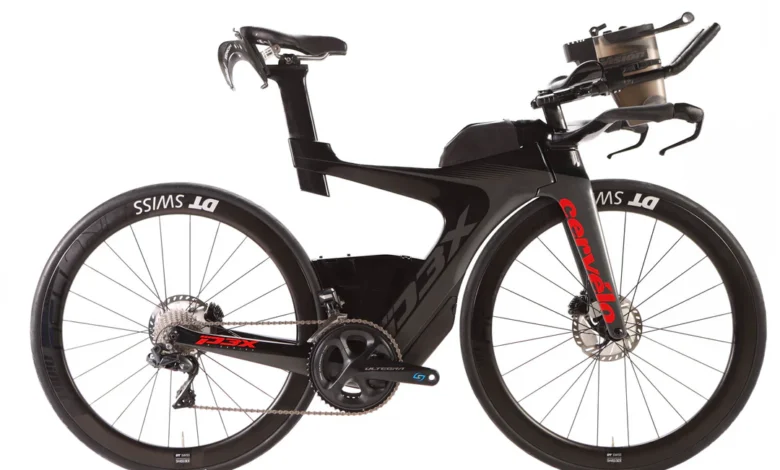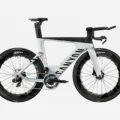Highlighting Key Features to Consider When Selecting a Triathlon Bike

When it comes to competing in a triathlon, selecting the right bike can make a significant difference in your performance. A triathlon bike is not just any ordinary bicycle; it is specifically designed to enhance speed, efficiency, and comfort during the rigorous demands of a triathlon race. In this blog post, we will delve into the essential features to consider when choosing a triathlon bike that will help you excel in your races. From understanding the basics of what makes a bike suitable for triathlon to exploring different types of triathlon bikes and key features to look out for, this guide will provide you with valuable insights to make an informed decision. Additionally, we will discuss the importance of additional accessories and equipment, as well as maintenance tips to keep your triathlon bike in top condition. Whether you are a seasoned triathlete or a beginner looking to invest in a high-performance bike, this comprehensive guide will equip you with the knowledge you need to make the best choice for your triathlon journey.
Understanding the Basics: What Makes a Bike Suitable for Triathlon
To understand what makes a bike suitable for triathlon, it is important to grasp the fundamental characteristics and design elements that optimise performance in this sport. Here are the key aspects to consider:
- Aerodynamics: Triathlon bikes are engineered to minimize wind resistance, allowing you to maintain higher speeds with less effort. Look for features such as aero-shaped frames, integrated handlebars, and streamlined designs that slice through the air efficiently.
- Geometry: Triathlon bikes typically have a more aggressive geometry compared to standard road bikes. They often feature steeper seat tube angles, shorter top tubes, and extended reach to put you in a more aerodynamic position for improved speed and power transfer.
- Frame Material: Triathlon bikes are commonly made from lightweight materials such as carbon fibre or aluminium. Carbon fibre frames offer excellent strength-to-weight ratio and vibration-damping properties, while aluminium frames provide durability and affordability.
- Integrated Storage Solutions: Look for bikes that offer integrated storage solutions, such as aerodynamic water bottle holders, bento boxes, and frame-mounted storage compartments. These features allow you to carry essential items like nutrition, spare tubes, and tools without sacrificing aerodynamics.
- Brake Systems: Triathlon bikes may feature different brake systems, including traditional rim brakes or disc brakes. Disc brakes offer superior stopping power and modulation, especially in wet conditions, but rim brakes are still widely used and provide sufficient stopping power for most triathlon events.
- Gear Systems: Triathlon bikes often come equipped with specific gear systems, such as aero shifters mounted on the handlebars or integrated into the brake levers. These systems allow for quick and seamless gear changes, enabling you to maintain your cadence and momentum during transitions.
By understanding these basic features that make a bike suitable for triathlon, you can narrow down your options and choose a bike that aligns with your specific needs and racing goals. Remember, finding the right bike is not just about the brand or price tag, but rather how well it suits your body, riding style, and the demands of the triathlon discipline.
Exploring the Different Types of Triathlon Bikes
When it comes to triathlon bikes, there are several different types to choose from, each with its own advantages and considerations. Understanding the characteristics of each type will help you make an informed decision based on your specific needs and preferences. Let’s explore the different types of triathlon bikes:
- Time Trial Bikes: Time trial (TT) bikes are specifically designed for maximum aerodynamic efficiency. They feature aero-shaped frames, integrated handlebars, and deep-section wheels. The geometry of TT bikes puts the rider in a forward-leaning position, minimizing wind resistance. These bikes excel in flat and fast courses, making them a popular choice for triathletes who prioritise speed.
- Road Bikes: Road bikes are versatile and commonly used in triathlons, especially for beginners or those participating in non-drafting races. They have a more relaxed geometry compared to TT bikes, providing a comfortable riding position. Road bikes often come with drop handlebars, multiple gears for various terrains, and the ability to attach aerobars for added aerodynamics during races.
- Mountain Bikes: While less commonly seen in triathlons, mountain bikes may be used in off-road or cross-triathlon events. These bikes have sturdy frames, wide tyres with knobby treads for traction, and suspension systems to absorb shocks on rough terrains. Mountain bikes are designed for durability and manoeuvrability in challenging off-road conditions.
- Hybrid Bikes: Hybrid bikes are a combination of road and mountain bikes, offering a versatile option for triathletes who want to enjoy both on-road and off-road riding. These bikes feature a more upright riding position, and wider tyres for stability, and often come with mounting points for racks and fenders. Hybrid bikes are suitable for triathletes who participate in a variety of events or prefer a more relaxed riding style.
By understanding the different types of triathlon bikes, you can narrow down your choices based on your race goals, riding preferences, and the terrain you will be racing on. It’s important to test-ride various types of bikes to determine which one suits your body ergonomics and riding style best. Remember, selecting the right type of bike is crucial for optimal performance and enjoyment during your triathlon races.
Key Features to Consider in a Triathlon Bike
When selecting a triathlon bike, there are several key features that you should carefully consider. These features will greatly impact your performance, comfort, and overall experience during your triathlon races. Let’s explore the essential features to look out for:
- Frame Material: The material of the bike’s frame plays a significant role in its weight, durability, and comfort. Carbon fibre frames are popular in triathlon bikes due to their lightweight nature and ability to dampen vibrations. Aluminium frames are also common, offering durability and affordability. Consider your budget and desired ride characteristics when selecting the frame material.
- Aerodynamics: Aerodynamic design is crucial for reducing wind resistance and improving speed. Look for features like aero-shaped tubes, integrated handlebars, minimal drag components, and streamlined designs. These elements will help you maintain higher speeds with less effort, ultimately enhancing your overall performance.
- Bike Fit & Comfort: A proper bike fit is essential for comfort and injury prevention. Consider the bike’s geometry and adjustability options to ensure a comfortable riding position that allows for efficient power transfer. Look for features like adjustable seat height, fore/aft positioning, and stack/reach adjustments to accommodate your body dimensions.
- Wheel Size & Material: Wheel selection can significantly impact your bike’s performance. Consider factors such as wheel size (typically 700c), rim depth, and material (such as carbon fibre or aluminium). Deeper rims provide improved aerodynamics but may be more susceptible to crosswinds. Choose a wheelset that suits your racing conditions and personal preferences.
- Gear & Brake Systems: The gear and brake systems on a triathlon bike are crucial for smooth and efficient performance. Look for a drivetrain with a wide range of gears suitable for various terrains. Consider whether you prefer electronic or mechanical shifting. For brakes, choose between traditional rim brakes or disc brakes, considering factors such as braking power, modulation, and maintenance requirements.
These key features should be carefully evaluated when selecting a triathlon bike. It is recommended to consult with a knowledgeable bike professional or undergo a professional bike fitting to ensure that the bike you choose is optimised for your body and racing goals. Remember, a well-selected bike that suits your needs will enhance your performance and enjoyment during your triathlon races.
Additional Accessories and Equipment for Triathlon Biking
In addition to selecting the right triathlon bike, there are several additional accessories and equipment that can enhance your biking experience and performance during races. These accessories are designed to provide comfort, convenience, and functionality. Let’s explore some of the essential accessories for triathlon biking:
- Cycling Shoes: Proper cycling shoes are crucial for efficient power transfer and comfort. Look for shoes that offer a stiff sole for optimal power transfer and a secure closure system, such as Velcro straps or BOA dials, to ensure a snug fit. Triathlon-specific cycling shoes often have features like easy entry and drainage holes to facilitate quick transitions.
- Helmet: A high-quality helmet is a non-negotiable safety accessory for any cyclist. Look for a helmet that is lightweight, well-ventilated, and meets safety standards. Triathlon-specific helmets often feature aerodynamic designs and extended coverage at the back for added protection.
- Hydration System: Staying hydrated during a triathlon is essential. Consider a hydration system that allows you to conveniently sip water or sports drinks while maintaining your aero position. Options include aerobar-mounted bottle cages, hydration vests, or hydration systems integrated into the bike frame.
- Aero Bars: Aero bars, also known as tri-bars or clip-on bars, can significantly improve your aerodynamic position and overall speed. These handlebar extensions allow you to rest your forearms and adopt a more streamlined position, reducing wind resistance. Make sure to practice riding with aero bars to ensure comfort and control.
- Cycling Clothing: Investing in proper cycling clothing can greatly enhance your comfort and performance. Look for moisture-wicking and breathable fabrics to keep you cool and dry during the race. Triathlon-specific clothing often features quick-drying materials, a comfortable chamois for the bike leg, and streamlined designs to minimize drag.
These additional accessories and equipment can make a significant difference in your triathlon biking experience. Consider your specific needs, race distances, and personal preferences when selecting these items. It is also important to practice using these accessories during training to ensure they are comfortable and integrated seamlessly into your race strategy. Remember, the right accessories can enhance your performance and make your triathlon biking more enjoyable.
Maintenance and Care for Your Triathlon Bike
Proper maintenance and care are essential to keep your triathlon bike in optimal condition and ensure its longevity. Regular upkeep will not only enhance your bike’s performance but also prevent potential issues that could affect your races. Here are some key maintenance and care tips for your triathlon bike:
- Regular Cleaning and Inspection: After each ride, clean your bike thoroughly to remove dirt, grime, and sweat. Use a mild detergent, water, and a soft brush or cloth to clean the frame, wheels, and drivetrain. Regularly inspect your bike for any signs of wear, damage, or loose components. Pay attention to the chain, cassette, derailleurs, brakes, and tyres.
- Proper Storage: Store your triathlon bike in a clean, dry, and secure location. Avoid exposing it to extreme temperatures, direct sunlight, or excessive moisture. Consider using a bike rack or wall mount to keep it off the ground and prevent any accidental damage. Proper storage helps protect your bike from unnecessary wear and tear.
- Timely Repairs and Replacements: Address any issues promptly to prevent further damage or safety hazards. Regularly check and replace worn-out components such as brake pads, chains, cables, and tyres. Schedule routine maintenance with a professional bike mechanic to ensure that your bike is in optimal working condition.
- Safety Checks Before Every Ride: Before each ride, perform a safety check to ensure that your bike is safe and ready to go. Check tyre pressure, and brake functionality, and ensure that all bolts and fittings are properly tightened. Verify that the wheels spin freely and the gears shift smoothly. A quick pre-ride check can prevent potential accidents or mechanical failures.
By following these maintenance and care practices, you can prolong the lifespan of your triathlon bike and enjoy consistent performance during your races. If you are unsure about any maintenance tasks, seek assistance from a qualified bike mechanic or attend a bike maintenance workshop. Remember, a well-maintained bike will not only enhance your performance but also provide you with a safe and enjoyable riding experience.










